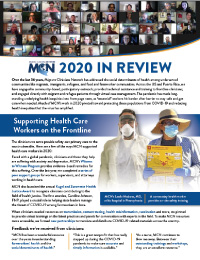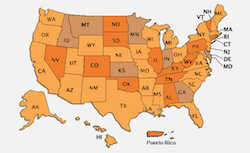- Who We Are
- Clinician Employment
- Publications
- Witness to Witness (W2W)
- Kugel & Zuroweste Health Justice Award
- Your Voice Matters: Photovoice Project
California Surveillance for Pesticide- Related Illness and Injury: Coverage, Bias and Limitations
The California Pesticide Illness Surveillance Program (PISP) is a major resource for pesticide illness epidemiology. This work attempts to improve characterization of pesticide illness in California, evaluate case ascertainment of the PISP and identify PISP’s limitations and biases for studying the incidence and epidemiology of pesticide-related illness.
CHAMACOS Study
The CHAMACOS study is a longitudinal birth cohort study examining chemicals and other factors in the environment and children's health.
In 1999-2000, CHAMACOS enrolled 601 pregnant women living in the agircultural Salinas Valley. They are following their children through age 12 to measure their exposures to pesticides and other chemicals and to determine if this exposure impacts their growth, health, and development.
Chronic Agricultural Chemical Exposure Among Migrant and Seasonal Farmworkers
Laboratory studies and case reports of accidental exposure to large amounts of chemicals indicate that there are immediate and long‐
Developing the 2012 National Action Plan for Protecting Children in Agriculture
Barbara C. Lee PhD, Susan S. Gallagher MPH, Amy K. Liebman MPA, MA, Mary E. Miller RN, MN & Barbara Marlenga PhD (2012)Journal of Agromedicine, 17:2, 88-93
Files
Development of a Surveillance Program for Occupational Pesticide Poisoning: Lessons Learned and Future Directions
Describes the growth from 1987 through 1996 of the Occupational Pesticide Poisoning Surveillance Program at the Texas Department of Health. The program was initially based on a Sentinel Event Notification System for Occupational Risks (SENSOR) model, using sentinel providers to report cases, supplementing the passive reporting by physicians that was required by law.
Development of a Surveillance Program for Occupational Pesticide Poisoning: Lessons Learned and Future Directions
The authors describe the growth of the Occupational Pesticide Poisoning Surveillance Program at the Texas Department of Health. The program was based on a Sentinel Event Notification System for Occupational Risks(SENSOR) model, using sentinel providers to report cases. The number of confirmed occupational cases increased from 9 workers in 1987 to 99 workers in 1996.
Effects of Social, Economic, and Labor Policies on Occupational Health Disparities
Carlos Eduardo Siqueira, MD, ScD, Megan Gaydos, MPH, Celeste Monforton, Dr PH, MPH, Craig Slatin, ScD, MPH, Liz Borkowski, BA, Peter Dooley, MS, CIH, CSP, Amy Liebman, MPA, MA, Erica Rosenberg, JD, Glenn Shor, PhD, MPP, and Matthew Keifer, MD, MPH
Background This article introduces some key labor, economic, and social policies that historically and currently impact occupational health disparities in the United States.
Farm worker receives settlement in insecticide-exposure suit
Greater Risks, Fewer Rights: U.S Farmworkers and Pesticides
Pesticide Action Network, United Farmworkers of America, and California Rural Legal Assistance Foundation analyzed California government data on agricultural poisonings and enforcement of worker safety standards. Nearly 500 pesticide poisonings were reported for California farmworkers every year. The actual number of pesticide-related illnesses is unknown, since many poisonings go unreported.
Health Care Access and Health Care Workforce for Immigrant Workers in the Agriculture, Forestry, and Fisheries Sector in the Southeastern US
Arthur L. Frank, MD, PhD, Amy K. Liebman, MPH, MA, Bobbi Ryder, BA, Maria Weir, MAA, MPH, and Thomas A. Arcury, PhD




